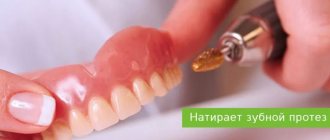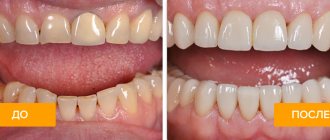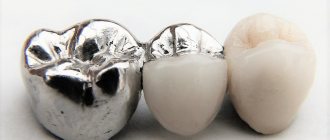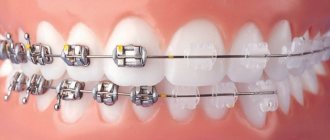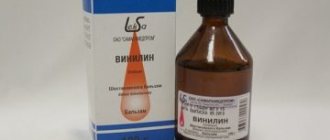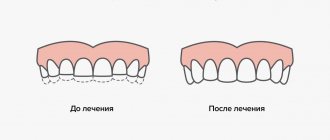21.11.2019
Modern dentistry allows patients not to worry about the loss of one or more teeth. Thanks to modern technologies, you can restore your smile without pain and without consequences. One of the innovations includes removable silicone dentures, reviews of which are mostly positive.
What are these structures?
Silicone dentures – what are they? Let's take a closer look, since there is still a lot of controversy surrounding these products. In fact, there is no such thing as a “silicone prosthesis.” But patients continue to call any flexible or elastic prosthetic structures this way. Because in the common understanding, silicone is something soft, unbreakable, quite elastic and even transparent.
And in dentistry there are materials that correspond to these characteristics. They are used for prosthetics, or more precisely, to imitate mucous membranes and for fastening elements (clasp hooks) to remaining teeth. There are no metal inclusions in the form of hooks or bases here. Suction cup dentures are attached to completely edentulous gums. Below we will definitely consider all flexible materials that have properties similar to silicone.
DENTAL PROSTHESIS ON 4 IMPLANTS - from RUB 140,000.
The price includes all procedures for installing Osstem implants (South Korea), including anesthesia and diagnostics.
Hurry up to sign up for a free consultation and fix your prices.
Call now or request a call
Opening hours: 24 hours a day - seven days a week
Dentists prefer to call dentures with “silicone” properties not soft, but flexible. Because such structures do not wrinkle, but only bend a little. Moreover, this flexibility manifests itself only at the stages of removal and fixation - this makes the patient more comfortable than with rigid acrylic dentures. But an already installed “silicone” prosthesis does not bend to the sides (especially a new one), does not move and fits the dentition quite tightly.
general information
Silicone prostheses have a translucent elastic base. They completely imitate the oral mucosa and the shape of the jaw. These are removable dentures with increased flexibility, softness and elasticity.
Silicone products are often compared with nylon ones, however, such a comparison is erroneous due to the presence of some design differences in silicone prostheses.
Plastic crowns are attached to the silicone base of the prosthesis. However, such fastening wears out quickly. After some time, discrepancy may occur, and gaps may appear between the real and artificial gums. Gradually, food gets clogged into such gaps, which has a bad effect on the condition of the oral cavity.
For this reason, silicone products have a short service life (from one to one and a half years). Some dentists generally recommend installing them as temporary.
Often these products are used as a partial denture in the absence of front teeth. They are also used when it is impossible to install a bridge (when there are no supporting teeth or a very large number of teeth need to be restored).
Silicone products are attached to the gums with special clasps. Sometimes they are also made of silicone.
Such structures can be used in case of loss of one or several teeth.
Note: A removable partial denture made of silicone is ideal for patients who have thinned alveolar ridges or have exostoses (bone protrusions).
To fix it, at least several teeth must be present in the dentition. Such a product will not put pressure on the soft tissues of the oral cavity.
Palateless removable silicone structures or products with a reduced laminar part can also be used. This option is great for patients with a pronounced gag reflex.
Classification of flexible structures
“Silicone”, or rather flexible products, are only removable. They are not made permanent. Let's consider the classification from the point of view of the length of the structure - i.e. how many teeth do they replace:
- single or “butterfly dentures”: replace 1-2 missing teeth, attached to adjacent teeth using clasps,
- partial: replace several missing teeth, incl. in different parts of the row. Attached with hooks to living teeth,
- full: worn with complete edentia, i.e. with complete absence of teeth. They are fixed only to the gums.
Varieties
Silicone prostheses can be:
- full;
- partial;
- single.
Most often, single structures are used. They are fixed with side clasp hooks attached to living teeth.
Partial dentures have the same attachments as single dentures. They are precisely matched to the patient’s tooth enamel, which gives high aesthetic results.
Complete dentures made of silicone are rarely used, mainly as temporary ones. Because they can damage natural teeth due to weak fixation.
Materials and types
As already noted, silicone-based dentures are not used in dentistry. And again, it is worth saying that indeed some materials for prosthetics have related properties - flexibility or elasticity, good colorability in the shade of natural mucous membrane at the manufacturing stage, translucency (if necessary). But still these are different materials. And what the patient himself understands as a “silicone prosthesis”, or some clinics offer under the name “silicone”, is actually one of the following materials:
- classic acrylic: an inexpensive material that was previously considered too hard and uncomfortable. Nowadays, options are used with the addition of diamond chips, so the dentures are lighter and more comfortable, last a long time,
- nylon: the most flexible material with almost perfect aesthetics, but only in the first year of wear. Then it stretches excessively and is not subject to complex repairs. The most popular manufacturer is Perflex Flexinylon,
- polyurethane: these are domestic designs made from materials - “Dentalur” and the more modern “Pentalur”. They are considered analogues of nylon, but are more rigid and not as porous. Can be repaired
- monomer-free acrylic Acry-free (“Acry-free”): does not contain a monomer (methyl methacrylate, which is found in classic acrylic), which can provoke allergies. Less flexible than nylon, but very durable. To be repaired
- Dental D from Quattro Ti (“Quadrotti”): this Italian material is distinguished by high aesthetics and low flexibility. It has one peculiarity - when restoring the upper jaw, instead of a fused artificial palate, a thin bridge is made here, like in clasp ones. Therefore, “Quadrotti” is often called their analogues. Can be repaired for minor defects. Not suitable for completely edentulous patients.
You can read more about each variety - features, characteristics, pros and cons - by following the links.
This is interesting! Specifically, silicone materials can be used to take impressions (molds) before prosthetics.
At the stage of manufacturing a denture, silicone is used as an auxiliary material - to create a model1 of new teeth, for fastening elements, and as silicone keys for veneers.
A few simple rules for cleaning dental plaque from dentures
- The best remedy that dentistry offers today are special tablets. These are oxygen-containing substances that actively affect plaque and food debris. They are very easy to use: just put the tablet in a container with water, put the prosthesis there overnight and leave it for oxygen exposure. In the morning you will receive a completely clean and pleasantly smelling prosthetic device.
- When brushing traditionally with a toothbrush, it is recommended not to use toothpastes with abrasives. This is because the soft tissue of the silicone prosthesis can be scratched or damaged. It is advisable to choose a toothbrush with soft bristles. Children's toothpastes or liquid dish soap are excellent cleaning agents.
- Silicone dentures, just like healthy teeth, need to be cleaned in hard-to-reach areas. To do this, you can use dental floss or special dental irrigators. If there are places in the denture that you cannot reach, then dental hygienists can help you. Daily use of a silicone denture requires regular visits to the dentist for effective hygiene and necessary adjustments.
The LeaderStom dental clinic offers you to use our services and the services of our doctors. The high level of qualifications of specialists allows us to recommend to patients the most optimal and affordable types of dental structures. We use only high-quality drugs and materials from well-known global manufacturers. Tested and certified products guarantee that you will be able to use a silicone prosthesis for a sufficiently long time. Make an appointment, and at the first consultation we will decide which prosthesis option will be best for you.
Indications and contraindications for the use of such structures
Dentists may suggest installing an elastic prosthetic structure for the following indications:
- absence of teeth (one or more),
- complete edentia,
- allergy to regular acrylic: the monomer contained in acrylic structures can cause irritation and swelling of the gums - especially if the manufacturing technology is not followed,
- when there are contraindications to fixed prosthetics: for example, in patients with decompensated diabetes mellitus, cardiovascular and endocrine pathologies, in children, pensioners, and during pregnancy.
Contraindications are the presence of mobile teeth (the prosthesis will loosen them until they fall out completely), as well as mental pathologies, when the patient may unknowingly swallow an artificial “jaw”. The presence of stomatitis and caries is also considered a contraindication, but a relative one - after treatment you can get prosthetics.
Advantages of elastic prosthetic structures
The following positive qualities are considered to be the advantages of removable flexible structures:
- small weight of the product,
- minimal number of contraindications (can be given even to children),
- hypoallergenic,
- relatively low cost of prosthetics,
- higher level of wearing comfort (compared to conventional acrylic ones).
PROSTHETICS WITH 6 OSSTEM IMPLANTS FROM RUB 200,000.
Complex implantation Osstem (South Korea) with delayed loading after 4-6 months.
Call now or request a call
“I didn’t know what kind of prosthesis to put in after the bridge fell out along with my front teeth. And it lasted only 3 years ((The dentist advised me to make some new clasps, called “Quadrotti”. She said that they are in use now, light and comfortable. Well, or get implants. But I haven’t decided on them yet, but “Quadrotti” "We did it. It’s really comfortable with them, but we’ll see how things go.”
Alena K., review from gidpozubam. ru
Acry-Free prostheses
Such prostheses are made from a completely new monomer-free material, Bio Acry Free. Unlike silicone (nylon) and acrylic structures, they have great advantages when worn and a minimum of contraindications.
Their main advantage is the ability to repair if the structure breaks down and a more uniform distribution of the chewing load, thanks to a slightly more rigid base compared to nylon. In addition, dentures made from Acre Free are much easier to polish than other structures. This means that plaque practically does not accumulate on them, which, however, does not negate the full care of the structure.
What can you say about the cons?
Flexible orthopedic structures have many more disadvantages than advantages. Let's take a closer look at their disadvantages:
- the likelihood of displacement and falling out of the mouth: it is elasticity that leads to the fact that chewing pressure is not very correctly redistributed to the jaw bone, so inconvenience may occur when eating,
- damage to supporting teeth: they are overloaded and fail faster,
- gum injuries from the pressure of clasps,
- discomfort: full dentures with a massive palate can cause nausea, prevent you from tasting food, lead to excessive salivation,
- need for adaptation: getting used to removable ones, even if they are small, quite long - at least 7-10 days,
- the risk of irreversible changes in the properties of the material: excessive stretching of the base as a result of active use (applies mostly to nylon) will lead to the fact that the prosthesis will have to be changed before the declared “shelf life” expires,
- increased adhesion of food to the nylon base: the inner part is rough and, as hygiene deteriorates, it becomes a place for the accumulation of microbes that provoke inflammation.
Alternative solutions
Removable dentures have a huge number of disadvantages - they fall out of the mouth, are poorly fixed, cause pain in the gums, and rub the mucous membranes. Therefore, if financial opportunity allows, it is best to undergo dental implantation. Moreover, if all teeth are missing, this process will only take 5-7 days. For example, you can consider treatment protocols such as Trefoil, all-on-6, basal implantation or dental prosthetics on 4 implants - the cost, of course, is higher than classic removable prosthetics. And a lot. But imagine that you will be able to eat again without restrictions, with taste, without pain and fear that the denture will fall out. And there is no need to talk about aesthetics - implant-supported dentures certainly look a thousand times more attractive.
How structures are made
Before any prosthetics, the patient must undergo preparation - to cure or remove diseased teeth, restore gum health, cure stomatitis. Ideally, do a computed tomography scan of the jaws, which will show the condition of the bone substance and the root system of the remaining teeth. After this, the orthopedic dentist takes impressions or impressions of the dentition and other parameters of the dental system (using an articulator, face bow).
It is impressions, as already mentioned, that can be made using silicone materials. To create and reline removable structures, as a rule, A-silicone is used.
Next, a model of the prosthesis is made from the impressions, which is tried on and modified in accordance with the edits. Materials acquire elastic properties under the influence of high temperatures during the manufacturing stage in a dental laboratory. In addition to the classic manual manufacturing method, modern thermoplastic materials (for example, Perflex Biosense) can be milled using CAD/CAM systems with the highest precision. Once the flexible denture is ready, sanded and polished, it is handed over to the prosthodontist.
Manufacturing technology.
Silicone-based structures are characterized by high biocompatibility and hypoallergenicity. They do not absorb odors and are also highly resistant to pigmentation and staining. The manufacturing process can take from 2 days to a week. Depending on the professionalism of the dentist, the technical equipment of the clinic and the length of the prosthesis, this period may vary. Work on the orthopedic device is carried out in several stages:
Clinical.
The dentist prepares the oral cavity and, if necessary, prescribes sanitation. Upon completion of the treatment procedures, impressions of the jaw are taken and a plaster model is created based on them.
Laboratory.
Based on the resulting model, a silicone base is produced, onto which artificial crowns are attached. The device is tried on by the patient and if it fits, the doctor fixes it on the gums.
Which material is better to choose, alternatives
Often a person cannot decide which prosthesis is better to choose - plastic or silicone (here we mean, of course, flexible). Let's figure it out. Plastic or plastic are popular “middle” names for acrylic prosthetic structures. That is, we will compare rigid and flexible products (although, in fact, almost all of them contain polymers, i.e. plastic). Hard ones are very durable, distribute pressure well, but can rub the mucous membrane2 and provoke its irritation. On the other hand, hard acrylic ones with compact dimensions (without a palate) can be fixed on implants - and this is the most reliable method of tooth restoration today. They can be called the best alternative to flexible removable dentures.
Flexible ones are also quite durable and do not rub your gums at first. But when the bone sag (and it will sag over time to one degree or another for everyone), then the flexible one will become uncomfortable and will rub. It can also stretch, and not all materials can be repaired. Elastic structures are not placed on implants.
REPROSTHETICS WITH ACRYLIC PROSTHETICS - RUB 200,000.
Re-prosthetics with an acrylic bridge on a metal frame (all included) up to 12 units.
Save RUR 30,000. Call now or request a call
Therefore, any removable options are recommended only as a temporary solution (especially nylon, which was created specifically for temporary wearing), or if there are significant contraindications to implantation. Otherwise, the choice depends on the clinical situation and the wishes of the patient - Acry-free or polyurethane for complete adentia, and Quattro Ti is the optimal solution for partial adentia.
Features of the procedure
In dental therapy, the silicone key method is an innovative solution. The technique reduces the time spent on restoration.
It is used to eliminate invisible dental caries. The cavity of the damaged unit is filled with a filling compound, and the last portion is given the correct shape using a template. Outlet channels are cut to prevent the composition from flowing.
It is possible to create an impression without a spoon. The work is carried out in stages, applying the composition layer by layer.
Recommendations for care and wearing
How to care for “silicone”, or more precisely, flexible or elastic dentures? Care is not very difficult, but it is quite monotonous. After all, after each meal, even after a small snack, you will have to remove the denture from your mouth and rinse it with clean running water. And also rinse your mouth. The structure must be cleaned using a special brush (available at any pharmacy) and a paste without scratching particles. Once a week you need to soak in a disinfectant solution - it is also sold at any pharmacy in the form of liquid or tablets.
Wearing it in the first days may not be comfortable, because you need to get used to the new “jaw”. Dentists recommend leaving it in your mouth for as long as possible without removing it at night. You can also recite tongue twisters and read aloud. In terms of nutrition, any hard food is a restriction, because... the structure may lose its fixation and fall out, or break under very strong pressure.
FAQ
Question
— How long does it take to get used to silicone structures?
Answer
“Basically, the patient gets used to such a prosthesis within a few weeks. This period may be accompanied by discomfort and a feeling of heaviness of the product in the mouth. There is increased salivation, irritation and pain. There are cases when the period of adaptation lasts up to several months.
Question
— What is the service life of such prostheses?
Answer
— Silicone prostheses gradually wear out. For this reason, constant corrections are required. To increase the lifespan of such structures, you need to visit a dentist at least once a year.
How much does it cost to restore teeth?
How much do elastic removable dentures cost? The price depends on the material - its quantity and characteristics, on the manufacturing features. The cost of prosthetics may increase due to the use of silicone materials for taking impressions. For example, silicone mixtures (A-silicone in particular) are an order of magnitude more expensive than alginate ones. If we look at prices for flexible structures specifically by product type, then an “immediate butterfly” made of nylon costs from 20 thousand rubles, Acry-free – also from 20 thousand, Quattro Ti – from 32 thousand, and polyurethane – from 35 thousand rubles.
1Haug S., Correct modeling, 2006. 2Galonsky V.G., Radkevich A.A. Reaction of the mucous membrane of the supporting tissues of the prosthetic bed to the influence of removable dentures, 2009.
Author: Chernov A. R. (Thank you for your help in writing the article and the information provided)
Life time.
In many ways, the duration of use of orthopedic systems depends on the quality of hygiene and compliance with operating rules. Basically, silicone devices are distinguished by their resistance to food dyes and are characterized as quite durable. The approximate shelf life of these structures is 5 years. The clinic where you were treated can give you a guarantee for 1-2 years, because... she is responsible only for the work of the orthopedic surgeon. If you regularly undergo preventive examinations, you will be able to prevent deformation of the prosthesis, and if necessary, a specialist will quickly correct any deficiencies that have arisen.

